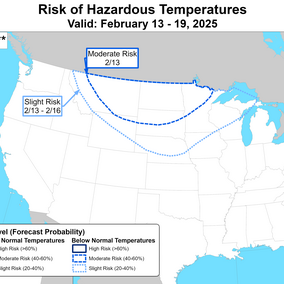
Published: September 26, 2025
Resources to Support Farmers and Ranchers Dealing with Stress
National Farm Safety & Health Week is Sept. 21–27, 2025
Susan Harris-Broomfield - Former Extension Educator for Rural Health, Wellness, and Safety, Soni Cochran - Nebraska EDEN Coordinator, Holly Hatton-Bowers - Assistant Professor in Child, Youth and Family Studies | Updated by: Michelle Krehbiel - Youth Development Specialist

Published: September 10, 2025
Warm and Wet Summer for Nebraska
Eric Hunt - Agricultural Meteorology and Climate Resilience Extension Educator

Published: May 14, 2025
Preparing for the 2025 Irrigation Season: Assessing Your System, Scheduling Tools and Soil Moisture Conditions Prior to First Irrigation
Abia Katimbo - Assistant Professor, Biological Systems Engineering, Todd Whitney - Extension Educator, Bruno Lena - Former Extension Educator, Ronaldo Marchezan - Research Technician III, Lucas De Matos Siebeneichler - WCREEC Intern, Karthik Burra - WCREEC Intern

Published: April 22, 2025
Pasture and Forage Minute: Budgeting Forage During Drought, Wheat Grazing vs. Grain Value
Plus Insights on Army Cutworm Scouting in Alfalfa
Shannon Sand - Agricultural Economics Extension Educator, Samantha Daniel - Extension Educator, Todd Whitney - Extension Educator

Published: February 28, 2025
Pasture and Forage Minute: Preparing for Drought
Hay Test TDN Values Decoded
Jerry Volesky - Nebraska Extension Range and Forage Specialist, Ben Beckman - Extension Educator

Published: February 21, 2025
Weekly Weather Outlook and Update: Feb. 21, 2025
Much Warmer Week Ahead
Eric Hunt - Agricultural Meteorology and Climate Resilience Extension Educator

Published: February 6, 2025
Winter in Full Force Next Week
Weekly Weather Outlook and Update: Feb. 6, 2025
Eric Hunt - Agricultural Meteorology and Climate Resilience Extension Educator

Published: January 24, 2025
2024 Was the Second Warmest Year on Record in Nebraska
December 2024 Climate Summary
Eric Hunt - Agricultural Meteorology and Climate Resilience Extension Educator

Published: January 24, 2025
A Break from the Polar Express Ahead
Weekly Weather Outlook and Update
Eric Hunt - Agricultural Meteorology and Climate Resilience Extension Educator










